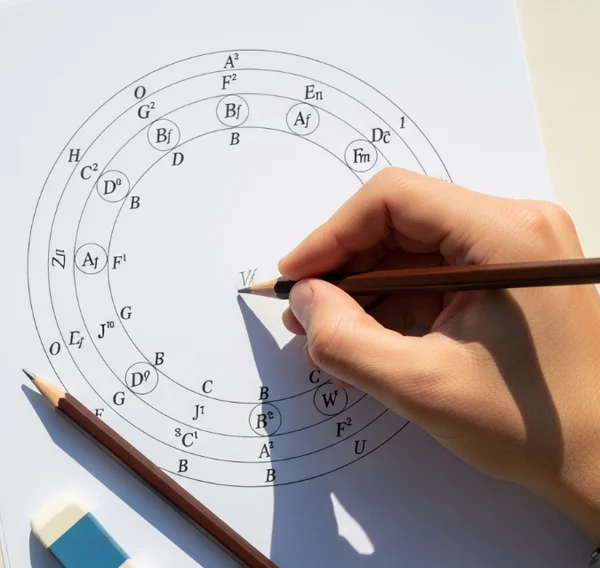Memorize Circle of Fifths Fast: Tips & Tricks
Struggling to get the Circle of Fifths to stick in your mind? You're not alone! Many musicians find this fundamental music theory tool a bit daunting at first. But how can I memorize the Circle of Fifths quickly? The good news is, with the right approach and a few clever techniques, you can conquer it faster than you think. This article will share effective tips, mnemonics, and practice strategies to help you memorize circle of fifths efficiently. And to make your learning journey even smoother, you can always try our interactive learning tool.
Why Bother Memorizing the Circle of Fifths?
Before we dive into the "how," let's briefly touch on the "why." Why is it so important to remember circle of fifths? Understanding it unlocks:
- Instant recognition of key signatures.
- Easier chord building and progression analysis.
- Smoother transpositions.
- A deeper grasp of overall music harmony. Essentially, it’s a cornerstone to learn music theory fast and effectively. Many find it challenging, but what are some easy tricks to remember the Circle of Fifths? Let's explore them.
Understanding the Basic Structure First
Before applying memory tricks, ensure you grasp the basic layout. The Circle arranges all 12 chromatic notes in a sequence of perfect fifths. Knowing this foundational logic helps any memorization technique. A great way for circle of fifths for beginners to start is by simply looking at a clear diagram.
The Importance of Visual Learning
Music is often visual, and the Circle of Fifths is no exception. Using a visual aid, like an interactive circle of fifths, can significantly aid memory. Being able to see the relationships and how key signatures change as you move around the circle reinforces learning.
Top Tricks to Memorize Circle of Fifths
Ready for some practical circle of fifths tricks? These methods cater to different learning styles, so find what works best for you!
The Power of Mnemonics: Acronyms and Phrases
Are there any good mnemonics for the Circle of Fifths? Yes, mnemonics are one of the most popular ways!
- For Sharps (Clockwise - C G D A E B F# C#):
- "Cats Go Down Alleys Eating Birds" (up to B)
- "Fat Cats Go Down Alleys Eating Birds" (starting from F, including F# and C# if you extend it: "Father Charles Goes Down And Ends Battle")
- For Flats (Counter-Clockwise - C F Bb Eb Ab Db Gb Cb):
-
"Can Fred Bring Elephants And Donkeys Grapes?"
-
"Battle Ends And Down Goes Charles' Father" (This is the reverse order of sharps, which is a trick in itself!) These circle of fifths mnemonics can be very effective.
-

Visual Association and Storytelling
Create a story or vivid mental images for each key signature and its position. For example, C major (no sharps/flats) is "home base." G major (one sharp) could be a "sunny G-arden with one sharp fence post." The more personal and vivid, the better you'll remember circle of fifths details. This is one of the best way to learn circle of fifths for visual learners.
Chunking: Breaking It Down
Don't try to learn all 12 keys at once. Break the Circle into smaller, manageable chunks.
- Focus on the "easy" keys first (C, G, D, F, Bb).
- Then tackle the keys with more sharps/flats. This gradual approach makes the task less overwhelming and is a solid strategy to learn music theory fast.
Practice Strategies for Long-Term Retention
Memorization is only half the battle; retention is key. What's the fastest way to learn music theory basics like the Circle? Consistent, smart practice.
Draw It Out Repeatedly
One of the simplest yet most effective circle of fifths study tips is to draw the Circle from memory every day. Start with a blank piece of paper and fill in the notes, then the key signatures. This active recall strengthens neural pathways.

Use an Interactive Tool for Reinforcement
Can an interactive tool help me memorize the Circle of Fifths? Absolutely! Our interactive circle of fifths tool allows you to click through keys, see relationships, and test your knowledge. It provides immediate feedback, making it an easy way to learn circle of fifths. For example, try to name the key signature before clicking on a key in the tool.
Apply It Musically
The ultimate way to memorize circle of fifths is to use it.
- When learning a new piece, identify its key signature and locate it on the Circle.
- Practice scales and chords by moving around the Circle.
- Try transposing simple melodies using the Circle as your guide. Practical application makes the information relevant and sticky. This is crucial for those wondering how can beginners best learn the Circle of Fifths?
Making it Stick: Consistency is Key
Like any skill, mastering the Circle of Fifths requires consistent effort. Short, regular practice sessions are more effective than long, infrequent ones. Combine these circle of fifths tricks and practice strategies, and you'll find yourself recalling it with ease. Remember that understanding circle of fifths quickly comes from a combination of smart techniques and dedicated practice.
Ready to put these tips into action? The journey to mastering this fundamental concept can be enjoyable and rewarding. And remember, our online Circle of Fifths is always here to help you visualize and practice.
What are your favorite mnemonics or tricks for remembering the Circle of Fifths? Share them in the comments below!
Your Circle of Fifths Memorization Questions Answered
-
How can I memorize the Circle of Fifths quickly?
Combine mnemonics (like "Father Charles Goes Down And Ends Battle" for sharps), visual association, regular drawing practice, and using an interactive learning tool. Chunking it into smaller sections also helps.
-
What are some easy tricks to remember the Circle of Fifths?
Acronym-based mnemonics are very popular. Also, remembering the order of sharps (F#, C#, G#, D#, A#, E#, B#) and flats (Bb, Eb, Ab, Db, Gb, Cb, Fb) helps, as does understanding that flats are the reverse of sharps if you start from a different point. Visualizing it as a clock face can also be an easy trick.
-
Are there any good mnemonics for the Circle of Fifths?
Yes! For sharps: "Father Charles Goes Down And Ends Battle." For flats: "Battle Ends And Down Goes Charles' Father." There are many variations, find one that resonates with you or create your own! Using these circle of fifths mnemonics can significantly speed up learning.
-
What's the fastest way to learn music theory basics like the Circle?
The fastest way usually involves a multi-pronged approach: understand the core concept, use memory aids like mnemonics, practice active recall (drawing it), and apply it musically. Interactive tools like the one on our website can also accelerate understanding.
-
How can beginners best learn the Circle of Fifths?
Beginners should start by understanding what the Circle represents. Then, focus on one mnemonic for sharps and one for flats. Draw it frequently. Use an interactive circle of fifths for beginners to see it in action. Don't try to learn everything at once; focus on the keys with fewer sharps/flats first.